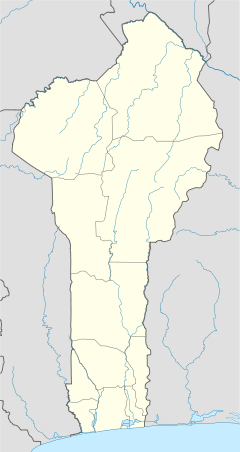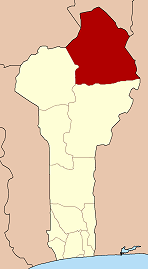| Kandi | |
|---|---|
| Commune, arrondissement and city | |
 Cathedral of Our Lady of Mount Carmel Cathedral of Our Lady of Mount Carmel | |
 | |
| Coordinates: 11°07′43″N 2°56′13″E / 11.12861°N 2.93694°E / 11.12861; 2.93694 | |
| Country | |
| Department | Alibori Department |
| Area | |
| • Total | 3,421 km (1,321 sq mi) |
| Elevation | 288 m (945 ft) |
| Population | |
| • Total | 177,683 |
| • Density | 52/km (130/sq mi) |
| Time zone | UTC+1 (WAT) |
| Postal address | BP: 30 |
| Area code | (+229) 23 |
Kandi [kɑ̃.di] is a town, arrondissement and commune in the Alibori Department of eastern Benin. Originally a market town, Kandi is now primarily a farming centre. It lies on the nation's main north-south highway, 650 km (400 mi) from Cotonou and 523 km (325 mi) north of Porto-Novo. The town is the capital of the department of Alibori. The commune covers an area of 3,421 km (1,321 sq mi) and as of 2013 had a population of 177,683 people. The town itself had a population of 27,227 in 2002.
History
Kandi was founded by the Bariba Kingdom, an offshoot of the Borgu Confederation. The surrounding villages are of the Bariba people in south and west, and the Mokole Yoruba in the north, who fled the wars of the foundation of the Oyo Empire.
Administrative divisions
Kandi is subdivided into 10 arrondissements: Kandi I, Kandi II, Kandi III, Angaradébou, Bensékou, Donwari, Kassakou, Saah, Sam and Sonsoro. They contain 39 villages and nine urban districts.
Economy
Most of the population are engaged in agricultural activities, followed by trade, transportation and handicrafts. There are notable iron deposits of high quality in the vicinity. The main crops grown are maize, cotton, kapok, millet and peanuts.

Bombax costatum ('false kapok'; 'Kapokier à fleurs rouges') is locally important as an agriforest subsistence crop: its flowers and calices are used as food; its leaves provide fodder, while kapok fibre is obtained from its seed pods. For Benin as a whole, cotton (Gossypium spp.) is the most important crop for its international trade: In 2018, ninety-five percent of the country's cotton production was exported; cotton earned eighty percent of Benin's export income. As a cash crop, it makes a crucial contribution to the incomes of local farmers. Kandi is a major centre of the cotton-growing region and cotton-ginning factories in the commune provide local employment.
Transport
The town is situated on the RNIE 2 highway and is served by Kandi Airport, which is located north of the main town.
Geography
The commune of Kandi is located 650 kilometres (400 mi) from Cotonou, in the Sudanian savanna zone. Communally it is bounded to the north by Malanville, south by Gogounou, west by Banikoara and to the east by Ségbana.
Climate
Kandi has a tropical savanna climate (Köppen climate classification Aw).
| Climate data for Kandi (1961–1990, extremes 1921–present) | |||||||||||||
|---|---|---|---|---|---|---|---|---|---|---|---|---|---|
| Month | Jan | Feb | Mar | Apr | May | Jun | Jul | Aug | Sep | Oct | Nov | Dec | Year |
| Record high °C (°F) | 41.2 (106.2) |
43.0 (109.4) |
43.3 (109.9) |
43.9 (111.0) |
43.3 (109.9) |
40.9 (105.6) |
38.9 (102.0) |
39.9 (103.8) |
39.8 (103.6) |
41.5 (106.7) |
39.5 (103.1) |
39.5 (103.1) |
43.9 (111.0) |
| Mean daily maximum °C (°F) | 33.6 (92.5) |
36.4 (97.5) |
38.4 (101.1) |
38.6 (101.5) |
36.2 (97.2) |
33.3 (91.9) |
30.9 (87.6) |
30.2 (86.4) |
31.1 (88.0) |
34.2 (93.6) |
35.3 (95.5) |
33.8 (92.8) |
34.3 (93.7) |
| Daily mean °C (°F) | 24.9 (76.8) |
27.8 (82.0) |
30.9 (87.6) |
32.1 (89.8) |
30.4 (86.7) |
28.1 (82.6) |
26.4 (79.5) |
26.0 (78.8) |
26.2 (79.2) |
27.8 (82.0) |
26.5 (79.7) |
24.8 (76.6) |
27.7 (81.9) |
| Mean daily minimum °C (°F) | 16.1 (61.0) |
19.2 (66.6) |
23.4 (74.1) |
25.6 (78.1) |
24.6 (76.3) |
22.9 (73.2) |
21.9 (71.4) |
21.8 (71.2) |
21.4 (70.5) |
21.4 (70.5) |
17.7 (63.9) |
15.8 (60.4) |
21.0 (69.8) |
| Record low °C (°F) | 10.0 (50.0) |
12.6 (54.7) |
15.2 (59.4) |
17.0 (62.6) |
16.5 (61.7) |
14.9 (58.8) |
18.6 (65.5) |
19.0 (66.2) |
15.0 (59.0) |
14.0 (57.2) |
10.8 (51.4) |
5.0 (41.0) |
5.0 (41.0) |
| Average precipitation mm (inches) | 0.3 (0.01) |
1.3 (0.05) |
6.9 (0.27) |
35.5 (1.40) |
122.6 (4.83) |
148.2 (5.83) |
213.2 (8.39) |
263.2 (10.36) |
197.5 (7.78) |
52.5 (2.07) |
0.1 (0.00) |
0.0 (0.0) |
1,041.3 (41.00) |
| Average precipitation days (≥ 1.0 mm) | 0 | 0 | 1 | 4 | 9 | 11 | 16 | 19 | 16 | 6 | 0 | 0 | 82 |
| Average relative humidity (%) | 33 | 28 | 36 | 52 | 65 | 75 | 82 | 85 | 85 | 76 | 54 | 40 | 59 |
| Mean monthly sunshine hours | 271.0 | 239.3 | 240.7 | 238.6 | 247.0 | 233.1 | 202.7 | 174.6 | 195.3 | 261.0 | 281.5 | 285.1 | 2,869 |
| Source 1: NOAA (precipitation, sunshine hours 1991-2020) | |||||||||||||
| Source 2: Deutscher Wetterdienst (humidity, 1951–1967), Meteo Climat (record highs and lows) | |||||||||||||
See also
References
- Benin at Geohive Archived 2016-08-28 at the Wayback Machine
- ^ "Kandi (Benin)". Encyclopædia Britannica. Retrieved January 10, 2010.
- ^ "Kandi". Atlas Monographique des Communes du Bénin. Archived from the original on February 26, 2009. Retrieved January 5, 2010.
- "Communes of Benin". Statoids. Archived from the original on March 24, 2012. Retrieved January 5, 2010.
- Kapok sources:
- Achigan-Dako, Enoch; Pasquini, Margaret; Assogba-Komlan, Francoise; Sognigbé, Ndanikou; Dansi, Alexandre; Ambrose-Oji, Bianca (eds.). Traditional vegetables in Benin: Diversity, distribution, ecology, agronomy, and utilisation (PDF). University of Bangor: School of Natural Sciences.
- Assogba, Gnido Amandine; Fandohan, Adandé Belarmain; Salako, Valère Kolawolé; Assogbadjo, Achille Ephrem (28 November 2017). "Usages de Bombax costatum (Malvaceae) dans les terroirs riverains de la Réserve de biosphère de la Pendjari, République du Bénin". Bois & Forêts des Tropiques (in French). 333: 17−29. doi:10.19182/bft2017.333.a31465.
- Cotton and cotton processing sources:
- Adjobimey, Mênonli; Hinson, Vikkey; Mikponhoué, Rose; Hountohotegbe, Esdras; Klikpo, Elvyre; Mama Cissé, Ibrahim; Adjogou, Amelée; Dossougbété, Véronique; Campbell, Jonathon R.; Ayélo, Paul; Houinato, Dismand (9 June 2022). "Occupational stress in industry setting in Benin 2019: A cross-sectional study". PLOS ONE. 17 (6): e0269498. doi:10.1371/journal.pone.0269498. PMC 9182257. PMID 35679301.
- Jacquet, Iskid; Wang, Jieyong; Zhang, Jianjun; Wang, Ke; Liang, Sen (10 June 2022). "An Understanding of Education in Supporting Cotton Production: An Empirical Study in Benin, West Africa". Agriculture. 12 (6): 836. doi:10.3390/agriculture12060836.
- "KANDI Climate Normals 1961-1990". National Oceanic and Atmospheric Administration. Retrieved June 11, 2016.
- "World Meteorological Organization Climate Normals for 1991-2020". National Oceanic and Atmospheric Administration. Retrieved January 4, 2024.
- "Klimatafel von Kandi, Prov. Borgou (Nordost) / Benin" (PDF). Baseline climate means (1961-1990) from stations all over the world (in German). Deutscher Wetterdienst. Retrieved 11 June 2016.
- "Station Kansi" (in French). Meteo Climat. Retrieved 11 June 2016.
External links
- Plan de Développement Communal de Kandi (in French)
| Banikoara |  | |
|---|---|---|
| Gogounou | ||
| Kandi | ||
| Karimama | ||
| Malanville | ||
| Ségbana | ||
| Yoruba topics | |||||||||
|---|---|---|---|---|---|---|---|---|---|
| History | |||||||||
| Subgroups | |||||||||
| Yoruboid languages | |||||||||
| Politics | |||||||||
| Geography (Yorubaland) |
| ||||||||
| Demographics | |||||||||
| Culture | |||||||||
| Education & philosophy | |||||||||
| Yoruba Misplaced Pages | |||||||||
